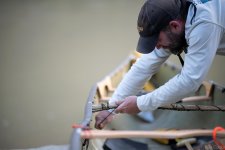- Joined
- Jun 22, 2017
- Messages
- 1,231
- Reaction score
- 1,471
Cathy, the BlackLite is much stronger and tougher than you might imagine. I think you'll have 3 challenges and none have to do with the strength and durability of the boat. First you will wonder how such a light boat could be so strong and tough. Second you may freak out because scratches show up so well on black carbon/Kevlar boats. I've gotten a couple of amazing bargains on black carbon/Kevlar canoes because the inexperienced owners are freaked out by a few minor scratches that do zero harm to the boat. Third and perhaps most important is that it takes some time and experience to learn just how strong carbon/Kevlar boats (and carbon fiber paddles) are. I have some super lightweight carbon fiber paddles that have taken full power hits on rocks for years with no ill effects. In one of my carbon/Kevlar tandem canoes we went over a big wave and the front half of the boat was out of the water (you might think the boat could snap in half) and the boat handled it easily...beaver dams will be no problem at all for you. Even that one chip in the pic of my boat's gelcoat came from a hard direct hit on the dry exposed square corner of a concrete barrier and the boat just bounced off (several times...the sound was not pleasant). Even that chip could have been permanently repaired with a small piece of gorilla tape and a BlackLite boat without gelcoat would almost surely just been scratched. You would not have to baby a BlackLite boat and I've pulled a carbon/Kevlar canoe over partially/mostly submerged rocks many times and it may not even leave a mark. If you search the canoe forums or google looking for feedback on Bell's Black/Gold lay-up (Bell is Northstar's predecessor with the same owner) or Northstar's BlackLite you cannot find any negative experiences but you CAN find many stories of impressive experiences ("boat flew off car at highway speeds and expected it to be destroyed but it was fine with just scratches", "went through a drive-through with boat on rack and hit an overhead sign and knocked sign down but boat was fine", etc). I'm going to send you a private message with the phone number of someone you can and should talk to to add to your peace of mind.


